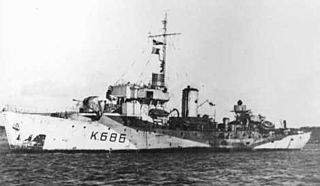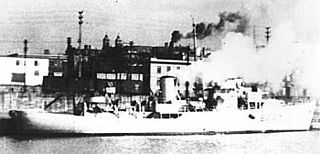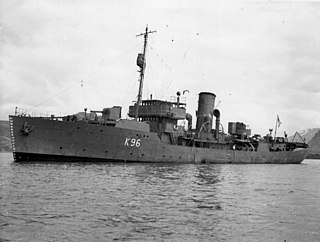
HMCS Oakville was a Royal Canadian Navy Flower-class corvette which took part in convoy escort duties during the Second World War. She fought primarily in the Battle of the Atlantic. After the war she was sold to the Venezuelan Navy. She was named after Oakville, Ontario.

The Flower-class corvette was a British class of 294 corvettes used during World War II by the Allied navies particularly as anti-submarine convoy escorts in the Battle of the Atlantic. Royal Navy ships of this class were named after flowers.

HMCS Alberni was a Flower-class corvette that served in the Royal Canadian Navy (RCN) during the Second World War. The Flower-class corvettes were warships designed for anti-submarine warfare. The ship was constructed by Yarrows Ltd. in Esquimalt, British Columbia, laid down on 19 April 1940, launched on 22 August and commissioned on 4 February 1941. The corvette sailed east to join the RCN's fleet in the Atlantic via the Panama Canal, where upon arrival, the vessel began escorting trans-atlantic convoys in the Battle of the Atlantic. Alberni took part in the key convoy battle of Convoy SC 42. In 1942, the corvette was transferred to Allied convoy assignments associated with Operation Torch in the Mediterranean Sea. In 1944, Alberni was among the Canadian naval vessels assigned to Operation Neptune, the naval component of the invasion of Normandy and escorted support ships to and from the United Kingdom on D-day.

HMCS Moose Jaw was a Royal Canadian Navy Flower-class corvette which took part in convoy escort duties during the Second World War. Together with HMCS Chambly, she achieved the RCN's first U-boat kill of the war. She was named after Moose Jaw, Saskatchewan.

HMS Mallow was a Flower-class corvette commissioned into the Royal Navy that served as a convoy escort during World War II; with the Royal Navy in 1940–1944, and with the Royal Yugoslav Navy-in-exile in 1944–1945. In Yugoslav service she was renamed Nada. Her main armament was a single 4-inch (102 mm) Mk IX naval gun, although a significant number of secondary and anti-aircraft guns were added towards the end of the war. During the war she escorted a total of 80 convoys whilst in British service, sinking one German U-boat, and escorted another 18 convoys whilst in Yugoslav service. After the war she served in the fledgling Yugoslav Navy as Nada then Partizanka, before being returned to the Royal Navy in 1949. Later that year she was transferred to the Egyptian Navy in which she served as El Sudan until she was decommissioned in 1975.
HMS Marigold was a Flower-class corvette of the Royal Navy. She was launched on 4 September 1940 and was sunk by an Italian air-dropped torpedo on 9 December 1942.
HMCS St. Thomas was a Castle-class corvette of the Royal Canadian Navy. She served during the Second World War in the Battle of the Atlantic, taking part in the sinking of the German U-boat U-877 in 1944. Initially ordered by the British Royal Navy as Sandgate Castle, the ship was transferred to Canada before completion. Following the war, the corvette was converted for mercantile use and renamed Camosun III, then Chilcotin and Yukon Star in 1958 before being broken up in Washington in 1974.

HMCS Battleford was a Flower-class corvette of the Royal Canadian Navy launched on 15 April 1940 and commissioned on 31 July 1941 during the Second World War. The corvette served primarily in the Battle of the Atlantic, escorting convoys of merchant ships. After the war she was sold to the Venezuelan Navy and renamed Libertad. Libertad was wrecked on 12 April 1949.

HMCS Fredericton was a Flower-class corvette of the Royal Canadian Navy. She was ordered from Marine Industries Ltd. in Sorel, Quebec and laid down on 22 March 1941. She was launched on 2 September 1941 and commissioned on 8 December 1941. She was named after the community of Fredericton, New Brunswick.

HMCS Amherst was a Flower-class corvette of the Royal Canadian Navy. She served primarily in the Battle of the Atlantic on convoy protection duty during the Second World War. She was named for Amherst, Nova Scotia. The ship was laid down at Saint John Dry Dock and Shipbuilding Co. Ltd. in Saint John, New Brunswick, on 23 May 1940 and launched on 3 December later that year. Amherst was commissioned on 5 August 1941 and served in the Battle of the Atlantic and Battle of the St. Lawrence, earning battle honours for both actions. After the war, the ship was decommissioned and sold to Venezuelan Navy in 1945 and renamed Carabobo. However, while en route to Venezuela, the ship was wrecked in the Gulf of St. Lawrence that same year.

HMCS Algoma was a Flower-class corvette that served with the Royal Canadian Navy in the Second World War. Named for the Algoma District of Ontario, it served primarily in the Battle of the Atlantic. After the war it was sold to the Venezuelan Navy and renamed Constitución.

HMCS Arrowhead was a Flower-class corvette that was originally commissioned by the Royal Navy but served primarily with the Royal Canadian Navy (RCN) during the Second World War. She fought primarily in the Battle of the Atlantic as a convoy escort. She was named for sagittaria, which is an aquatic water plant that is sometimes known as arrowhead.

HMCS Fergus was a modified Flower-class corvette that served with the Royal Canadian Navy during the Second World War. She fought primarily in the Battle of the Atlantic as a convoy escort. She was named for Fergus, Ontario. She was originally named Fort Frances but was renamed before launching. She was the last corvette launched by the Royal Canadian Navy.

HMCS Guelph was a modified Flower-class corvette that served with the Royal Canadian Navy during the Second World War. She fought primarily in the Battle of the Atlantic as a convoy escort. She was named for Guelph, Ontario.

HMCS North Bay was a modified Flower-class corvette that served with the Royal Canadian Navy during the Second World War. She fought primarily in the Battle of the Atlantic as a convoy escort. She was named for North Bay, Ontario.

HMCS Owen Sound was a modified Flower-class corvette that served with the Royal Canadian Navy during the Second World War. She fought primarily in the Battle of the Atlantic as a convoy escort. She was named for Owen Sound, Ontario.
HMS Teme was a River-class frigate of the Royal Navy that was built during the Second World War. The frigate was named for the River Teme, a river that flows along the English-Welsh border. She was transferred to the Royal Canadian Navy and served as HMCS Teme. She was torpedoed by a German submarine on 29 March 1945 and subsequently declared a constructive total loss. The ship was broken up in Wales in 1946.

HMS Aubrietia (K96) was a Flower-class corvette built for the Royal Navy (RN) from 1941-1946. She was active as a convoy escort in the Atlantic and Mediterranean. In May 1941, Aubrietia sighted and depth charged the German submarine U-110, leading to its capture and the seizure of a German Naval Enigma and its Kurzsignale code book.

HMS Delphinium (K77) was a Flower-class corvette built for the Royal Navy (RN) from 1940-1946. From 1941 to 1943 she was active in the Mediterranean as an escort to convoys supporting the Eighth Army and the invasion of Sicily. From mid-1943 onwards she was on convoy escort duties between Africa, the Mediterranean and the United Kingdom; and Atlantic convoys between North America and the United Kingdom. She escorted a total of 68 convoys.

HMS Poppy was a Flower-class corvette that served in the Royal Navy as a convoy escort during World War II.
















